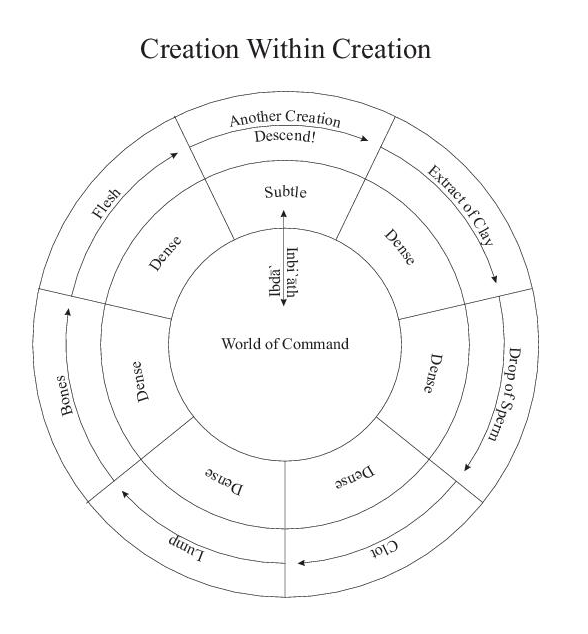Book of Healing - Spiritual Healing - Different Wisdoms
Different Wisdoms
Tags: Wisdom, Ilqa', Ilham, Waswasah, Hadith-i nafsi, Tawfiq, Hidayat, `Alam-i Dharr, haba', World of particles, Negative-like Wisdom, Record of Deeds, khalq-i akhar, subtle creature, Moth, Silk Worm
1. Q. Why do undesired and unwilling thoughts occur in the human heart? What can be their cause?
A. The heart is the fountainhead of life and the senses, therefore, for the continuity of the flow of the river of life, survival and consciousness, it is necessary for something to be there. Thus, when the heart is not in use with control, it is inspired with something of piety or insinuated with something of impiety (91:8), according to one's existing condition and state. Therefore, it is said that whatever occurs in the heart, has four origins: Divine (Rahmani), angelic, satanic and carnal. It is through these four ways that a thought automatically occurs in the heart. If it is Divine or angelic, it is called ilqa' or ilham, if satanic, it is called waswasah, or if it is carnal, then it is called Hadith-i nafsi.
2. Q. What is the recognition of tawfiq and hidayat individually and personally? And how can it be attained?
A. Tawfiq (success) and hidayat (guidance) consist of many levels, but its special form, according to the Qur'an, is: "No calamity befalls save by God's permission. And whoever believes (fully) in God, He guides his heart. And God is Knower of all things." (64:11). That is, when the believing servant passes through external and internal trials on the path of God, with `ibadat, spiritual exercises, knowledge and good deeds, He favours him with all kinds of special tawfiqat (successes) and guidance.
3. The prayers of the Prophets, may peace be on them: In the wisdom-filled stories of the Prophets in the Qur'an, there are great and exalted examples for the religious life of the people of faith. Among these bright examples are those words of prayer which they used to recite in the time of tribulations and calamities. These prayers are like special medicines of the heavenly hospital (=the Qur'an) for every individual Muslim. For these prayers were approved and accepted in the past and are still acceptable in the eyes of God, may He be blessed and exalted. For instance see: "La ilaha illa anta subhanaka inni kuntu mina'z-zalimin (There is no God save You. Purified be You! Surely, I have been among the wrong doers.)" (21:87).
4. Manifestation of the `Alam-i Dharr (The World of Particles): Dharr is the plural of dharrah. Dharrah is the name of an extremely tiny red ant; it also means a mote which appears in the sunshine coming through a window. A synonym of dharrah in the Qur'an is "haba'" (25:23; 56:6). Thus the `alam-i dharr means the world of particles, by which is meant the world of spiritual particles, which is called the microcosm as well as the personal world. It should be remembered that real spiritual progress starts with the manifestation of the world of particles. This manifestation is a great spiritual revolution and the observation of dazzling lights before this, is merely a great test.
5. Negative-like Wisdom: The multi-faceted character of the Qur'an (which means that every noble verse of the Qur'an has many facets of meaning) is mentioned in "Healing through Knowledge". For an example of this see verse (56:5-6): "And the mountains are ground to powder so that they may become scattered dust." That is, the soul which was solid like a mountain, now has its extremely small particles starting to fly, and every particle is a living soul. For the world of particles manifests itself from among these particles. The world of particles is also the record of deeds of every individual, as mentioned in verse (25:23): "And We will turn unto the work they did and make it as scattered dust." This is a negative-like wisdom, namely, a wisdom which apparently seems negative, but is not so in reality. For this is a veiled mention of a great secret of the record of deeds.
6. Record of Deeds (Book of Deeds): As mentioned in the above, the record of deeds will be utterly different from the books of this world and very wonderful, for it is based on the scattered particles of the soul, as mentioned in verse (17:13): "And We have fastened every man's record of deeds on his neck and We shall bring forth for him on the day of Resurrection as a book which he will find scattered." However, this will be the initial form of the book of deeds and eventually its manifestation will be as a luminous person.
7. Man, Jinn and Angel: Try to find out in the light of the wise Qur'an whether or not man, jinn and angel can be one at some place? Is there any link between them at present, or is each of them a totally separate creature from azal? These and other such questions are extremely important. In this connection, we would like to say that creation, in fact, takes place on the circle of nature, which the holy Qur'an has called "khalqan min ba`di khalqin (a creation after a creation, 39:6)" the details of which are in verses (23:12-14). Thus the last link of this circular chain is "khalq-i akhar (another creation, i.e. the subtle creation)", and the verse in which it is mentioned is: "Then We created it another (or ultimate) creature." (23:14).
8. The Perfect Creature: Another creature or the ultimate creature is man, but in the subtle body, which is both jinn and angel. Some proofs of this fact are:
- It is said in the Qur'an (23:12-14): "Verily We created man from a quintessence of clay, then We made it a drop of sperm, which remained in a secure place (now it did not remain quintessence of clay). Then We created the drop of sperm a clot (now it did not remain a drop of sperm), then We created the clot a little lump (now it did not remain a clot), then We created the little lump bones (now the little lump is totally changed), then We clothed the bones with flesh (in this state the physical creation of man became perfect, and being born in this world, continued to pass through the stages of life), then We made him another creature (khalqan akhar, i.e. the ultimate creature), or the subtle creature". Now it is free from bones and flesh. For in this Divine teaching it is crystal clear that in every following creation, the previous state does not remain.
- To say "another creature" is itself a bright proof that here the subtle creature is mentioned.
- To say "So blessed be God" is the third proof, for in this Divine attribute it is alluded that He confers the subtle creatures with blessings.
- The fourth proof is "the Best of creators", for in this praise of the Supreme Creator, the creation of the higher creatures is mentioned.

"Surely His is the creation and the command, blessed is Allah, the Sustainer of the worlds" (7:54).
Descent of the subtle creature is mentioned in verses (2:36; 2:38; 7:24; 20:123).
9. Moth and Silk Worm: One of the countless marvels and wonders of God's power is that by His command, the moth and the silk worm come into being from one another, of which the moth symbolises the subtle creature and the silk worm the dense creature. In reality, neither of them is anterior or posterior, rather both of them equally and simultaneously revolve on the circle of creation. In other words, in reality, they are the same one creature, which revolves on this circle. Certainly, it is the same law addressed to Hazrat Adam and the subtle or spiritual creatures: "Descend you all from it (Paradise)." (2:38). In short, they were all subtle in Paradise, but when they came down to this world, they became dense. Refer to the diagram above.
Nasir Hunzai,
London,
14 Safaru'l-muzaffar, 1409
26th September, 1988.
| Chapter Index | Previous Chapter | Next Chapter |
